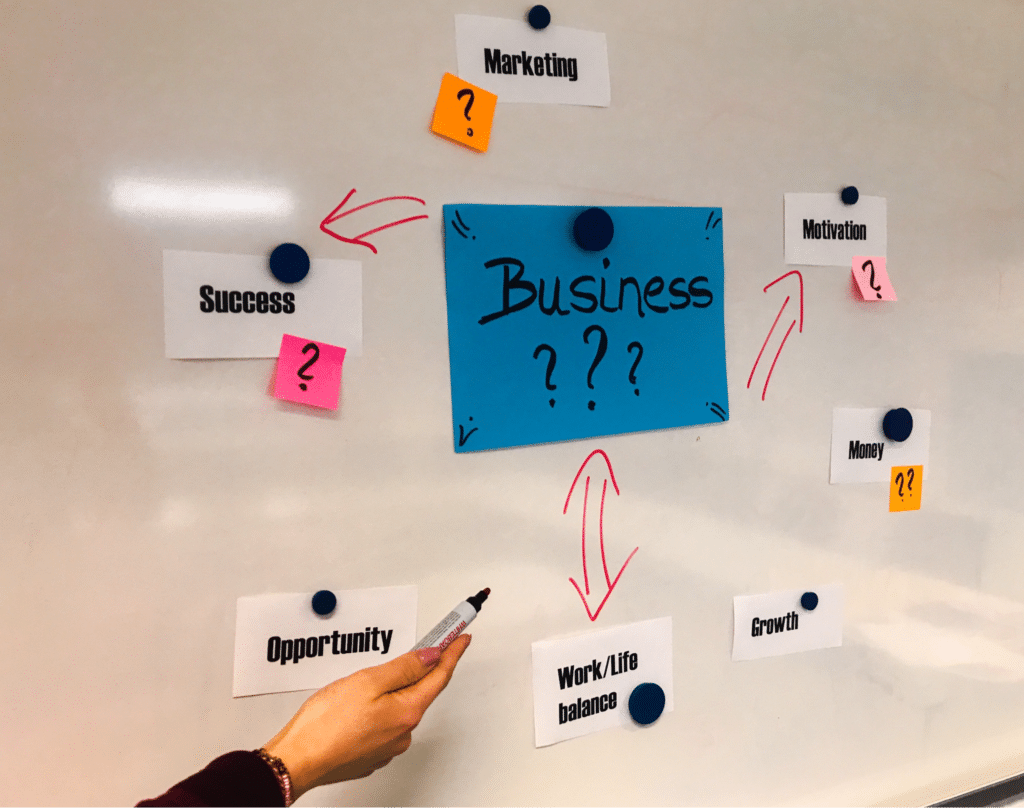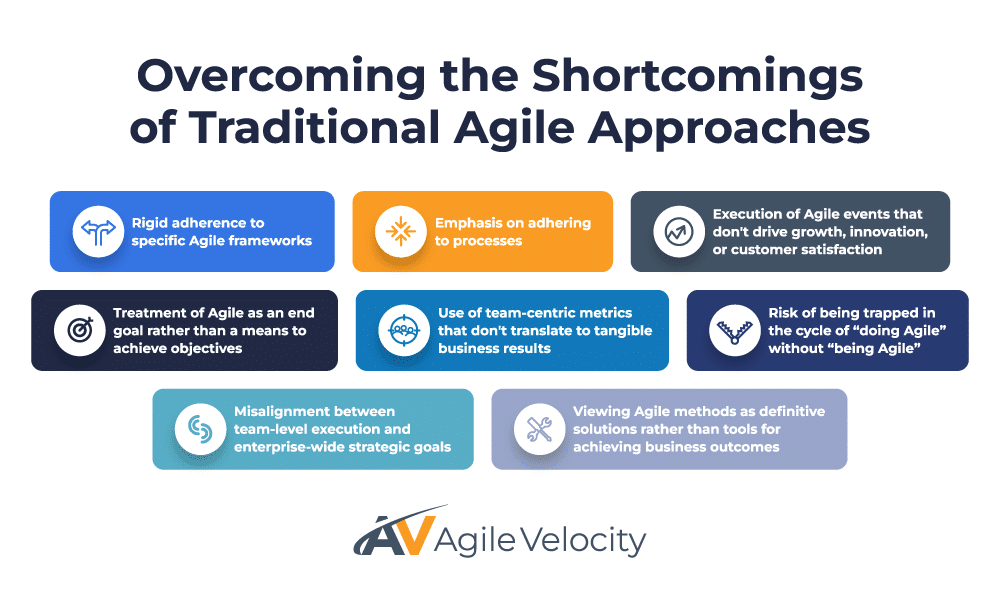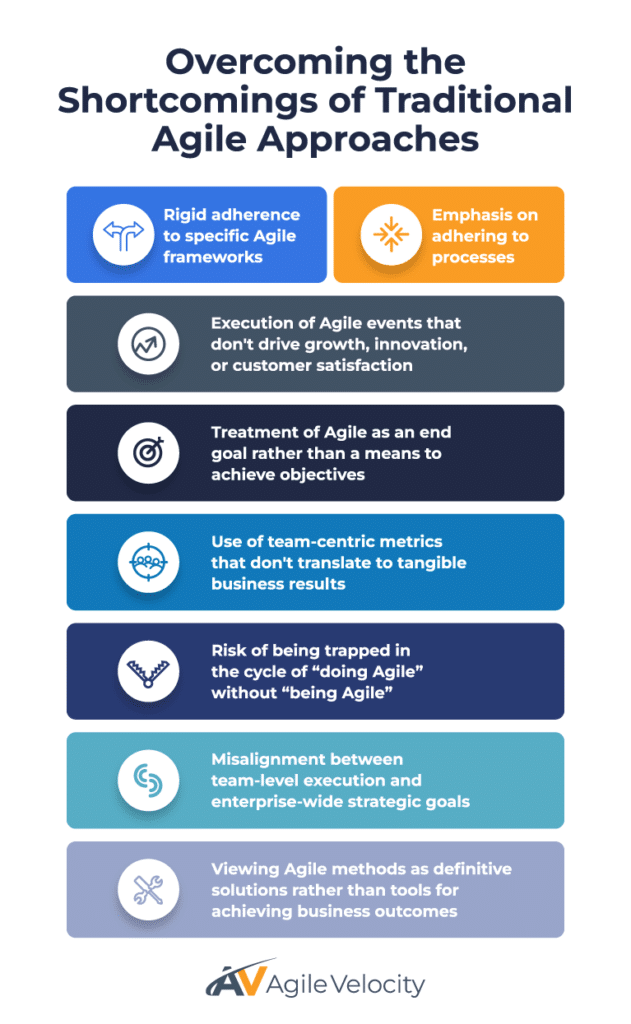The pursuit of organizational agility has become a cornerstone for businesses striving to succeed in today’s ever-changing landscape. However, many leaders are recognizing a fundamental truth: simply adopting an Agile Methodology or following popular frameworks does not guarantee tangible results. To truly make an impact, the focus must shift from processes to business outcomes. Prioritizing business outcomes means identifying and focusing only on what really matters—delivering measurable results, elevating customer satisfaction, and achieving strategic objectives.
In this article, we’ll uncover why organizational agility is more important than ever. We’ll examine the challenges often faced when adhering too rigidly to traditional Agile Methods and highlight how an outcome-oriented approach can drive meaningful change. You’ll also discover how tools like Path to Agility® Navigator and an outcomes-first mindset can help realize the full potential of an Agile Transformation.
Whether you’re an Agile coach, a technology leader, a Product Manager, or an executive rethinking your approach, this guide will equip you to transform Agile practices into a strategic advantage focused on real-world results
Why Organizational Agility is Key to Success
In today’s fast-paced business world, the ability to adapt swiftly to change isn’t just advantageous—it’s essential. However, Agile system coaching covers more than team-level flexibility. It’s a systemic capability encompassing leadership mindsets, team collaboration, continuous feedback, and a culture of ongoing improvement. By focusing on agility at every level, organizations can navigate unpredictable markets, evolving customer needs, and emerging technologies with confidence.
Adopting broader Agile adoption allows enterprises to stay one step ahead by fostering faster response times. Instead of being bogged down by lengthy decision cycles, Agile organizations leverage flexible structures and Lean Portfolio Management practices to adapt in real time. Feedback loops—whether from customers, stakeholders, or employees—become a key driver of informed decisions. Agile teams align these insights with broader organizational goals, ensuring they deliver valuable outcomes, not just outputs.
The competitive landscape in today’s business world will push businesses to embrace agility like never before. Rapid innovation, economic uncertainty, and shifting market dynamics will separate those that can adapt from those that fall behind. By embedding agility into their DNA, organizations not only stay relevant but also build resilience—enabling them to seize opportunities and overcome challenges as they arise.
The Limitations of Traditional Agile Methods
While frameworks like Scrum and Kanban are invaluable for optimizing delivery and improving team-level efficiency, relying solely on these methods can hinder wider organizational success.
Many enterprises fall into the trap of prioritizing adherence to processes over focusing on the bigger picture: delivering meaningful business outcomes. Teams may routinely execute Sprints, hold Daily Scrum events, and conduct Sprint Reviews or Sprint Retrospectives without truly driving growth, innovation, or customer satisfaction.
The problem often lies in treating Agile as an end goal rather than a means to achieve strategic objectives. Success is frequently measured using team-centric metrics such as velocity or story points. While these metrics provide insight into team performance, they rarely translate into tangible business results, such as increased revenue, greater market share, or enhanced customer loyalty. This disconnect keeps organizations trapped in the cycle of “doing Agile” without actually “being Agile,” where the focus remains on frameworks rather than delivering value.
In addition, rigid adherence to specific frameworks can lead to inflexibility. When teams are pressured to conform strictly to one methodology, opportunities for creativity, cross-functional collaboration, and innovation can be stifled. This approach often creates silos and inhibits alignment between team-level execution and enterprise-wide strategic goals.
Ultimately, while traditional Agile Methods are effective for managing workflows, they must be viewed as tools rather than definitive solutions. By shifting the focus from following processes to achieving outcomes, organizations can unlock the full potential of Agile Transformations.
Shifting from Agile Methods to Business Outcomes

Transitioning from a process-centric approach to an outcome-driven mindset empowers organizations to focus on what truly matters: delivering value, driving innovation, and maintaining adaptability. While Agile frameworks like Scrum or SAFe® (Scaled Agile Framework®) provide structured guidance to streamline delivery, they are tools—not the ultimate goal. Success should not be defined by adherence to rules, but by achieving measurable results such as increased market share, enhanced customer experiences, or better product quality.
An effective way to embrace this shift is by fostering an Agile mindset across all levels of the organization. Rather than encouraging teams to merely “stick to the framework,” leaders should create an environment that promotes experimentation and adaptability. For example, teams can use Sprint Planning and iterative roadmaps to align their day-to-day work with broader organizational objectives. This ensures that every action contributes directly to the company’s strategic priorities, making progress toward business outcomes the true measure of success.
By emphasizing outcomes over processes, organizations unlock greater flexibility and resilience. Teams operate with a clear purpose, gaining the ability to adapt frameworks as needed to fit evolving goals. The outcome-oriented approach moves beyond delivering outputs—it transforms Agile practices into powerful enablers of high-impact change.
Enhancing Outcome-Driven Agility with Path to Agility Navigator
Path to Agility Navigator provides organizations with a clear roadmap for transitioning from outdated, process-heavy methods to new, outcome-driven strategies. At its core, Path to Agility Navigator helps teams and leaders identify areas for improvement, adapt behaviors, and reshape structures to achieve measurable business outcomes. It emphasizes progress over process, ensuring organizations stay focused on delivering real value rather than simply ticking boxes.
Path to Agility Navigator shines by offering transparency into Agile initiatives across the enterprise. It visualizes progress, highlights strengths, and pinpoints areas that need further refinement, enabling teams to strategically prioritize their efforts. This approach ensures that every task contributes directly to the organization’s larger goals, whether it’s enhancing customer satisfaction, improving operational efficiency, or accelerating time-to-market.
A key advantage of Path to Agility Navigator is its adaptability. It is designed to work with a range of frameworks, such as Scrum and SAFe®, by focusing on outcomes instead of rigid methodologies. This flexibility enables organizations to pivot seamlessly when priorities or market conditions shift, making it an invaluable tool for navigating uncertainty and fostering continuous improvement.
By integrating Path to Agility Navigator into your Agile practices, you’ll gain a comprehensive view of your transformation journey. With its support, teams can align daily activities with strategic objectives, enhancing clarity and accountability across the board. This alignment not only drives meaningful results but also equips organizations with the agility and resilience needed to thrive in an ever-evolving business landscape.
Best Practices for Driving Outcome-Oriented Organizational Agility
Transforming your organization to prioritize outcomes requires intentional shifts in both structure and culture. By taking deliberate and strategic actions, you can foster an environment where Agile practices consistently deliver measurable business value. Below are actionable best practices to guide your journey toward outcome-oriented organizational agility:
Start with Small Wins Before Scaling
Begin by implementing an outcomes-first approach with a few pilot teams. These teams can showcase how shifting the focus from process adherence to business outcomes drives tangible results. Once positive outcomes are achieved, scale the approach across the organization, reinforcing successes as a model for others to follow.
Balance Short-Term Wins with Long-Term Vision
While small, incremental victories build momentum, it’s important to align them with your organization’s overarching strategic goals. Objectives like improving customer satisfaction, reducing operational costs, or increasing market share should serve as a guiding compass for short-term initiatives. This ensures every action contributes to both immediate results and sustainable growth.
Promote Transparency at All Levels
Transparent communication keeps everyone aligned on goals, progress, and challenges. Regular feedback cycles help teams understand how their work ties into broader business outcomes. Sharing progress openly fosters accountability, collaboration, and trust—essentials for successful Agile Transformations.
Leverage Lean Portfolio Management for Strategic Alignment
Aligning strategic priorities with Agile Release Trains, product lines, or team-level objectives ensures that funding and resources are directed to initiatives that deliver the most value. Real-time feedback loops from teams provide leadership with insights to adjust priorities as needed, creating a dynamic balance between planning and Agile execution. Being disciplined about investment selection also provides the organization the ability to really focus on and deliver the most valuable strategic work.
Encourage Cross-Functional Collaboration
Break down silos by fostering collaboration across departments and leadership levels. Cross-functional efforts ensure that teams work cohesively toward shared outcomes rather than optimizing solely within their own areas. This collaboration contributes to greater innovation and prevents disconnects between organizational goals and team-level delivery.
The Role of Leadership and Coaches in an Outcome-First Approach
Leadership plays a pivotal role in cultivating a culture that prioritizes outcomes over processes. Leaders who focus on results rather than rigid adherence to methodologies set the tone for innovation, collaboration, and alignment with strategic goals. By openly sharing organizational objectives and providing clarity on how these goals translate into day-to-day work, they empower teams to connect their efforts to meaningful outcomes. Regular alignment sessions with cross-functional stakeholders ensure that priorities remain consistent with the organization’s value streams, preventing misalignment and enabling agility at scale.
Agile Coaches are equally essential in facilitating this transition. Whether specializing in SAFe, Scrum, or Lean, Agile Coaches act as bridge-builders who connect strategic goals with execution on the ground. They guide teams and leaders in redefining success through measurable results rather than internal metrics alone. By fostering cross-functional collaboration, encouraging experimentation, and promoting continuous improvement, Agile Coaches help organizations maintain focus on driving tangible business value.
Strong leadership and coaching don’t just establish frameworks; they instill the mindsets needed to sustain an outcome-first approach. Leaders inspire teams to challenge conventional thinking, while coaches provide methods to turn strategy into action. When both work in tandem, organizations can move beyond superficial Agile practices to achieve deeper, more sustainable transformations—ensuring teams focus on delivering real-world results, such as improved profitability, better customer experiences, and increased innovation.
Overcoming Organizational Challenges When Transitioning to Outcome-Focused Agility
Transitioning to an outcome-focused Agile approach comes with its fair share of challenges. Teams may resist change due to a preference for familiar routines, while others might struggle to see how shifting focus benefits their daily work. Leadership adjustments, budget constraints, or misaligned priorities can further complicate the process. However, addressing these obstacles with intentional strategies can pave the way for success.
Address Resistance with Clear Communication
The first step in overcoming resistance is to clearly communicate the “why” behind adopting an outcome-focused approach. Show how this shift benefits not just the organization as a whole, but also teams, customers, and profitability. When individuals understand the tangible impact of their efforts—whether it’s creating better customer experiences or improving financial growth—they are more likely to embrace change. Hosting engaging interactive sessions that simulate real-world scenarios can also help people connect the dots between their day-to-day tasks and larger objectives.
Start Small and Build Momentum
Introducing change incrementally can make the transition feel more manageable. Begin with pilot teams that use an outcome-focused approach, then share these successes organization-wide. Demonstrating early wins, such as a faster time-to-market or higher customer satisfaction, encourages others to adopt this mindset confidently.
Align Tools and Training to Practical Outcomes
Providing teams with the right tools and resources is essential to building a strong foundation for success. Agile training sessions should go beyond teaching frameworks to emphasize tying metrics to meaningful business impact. Using Path to Agility Navigator helps teams and leadership visualize progress, identify growth areas, and stay aligned with strategic goals. Additionally, leveraging AI Solutions for agile teams can enable swift, informed decisions that support value delivery.
Foster Collaboration in Hybrid Work Environments
The rise of hybrid work presents unique challenges, but it also offers opportunities for enhanced collaboration. Hosting regular Return to Office Events or virtual strategy sessions can encourage cross-functional communication while reinforcing alignment on shared objectives. Even something as simple as requiring that cameras be turned on during virtual meetings can add to collaboration; it’s much easier to have high value conversations with a person than with an avatar. These touchpoints help bridge communication gaps between remote and on-site teams, ensuring unity around outcomes.
Leverage Agile Staffing and Continuous Improvement
Ensuring the right people are in the right roles is another key factor in overcoming obstacles. Agile Staffing practices that match skilled, adaptable individuals with targeted needs can help fill roles quickly. At the same time, promoting continuous improvement keeps teams flexible and committed to achieving outcomes, even as challenges evolve.
Measuring Success in an Outcome-Driven Agile Transformation

Tracking the right metrics is essential for evaluating the progress and impact of an outcome-driven Agile Transformation. Rather than relying solely on traditional Agile metrics like story points or burndown charts, organizations must shift their focus to indicators that demonstrate tangible business outcomes. These measurements should align with broader strategic goals, ensuring every effort contributes to meaningful results.
Customer-Centric Metrics
Customer satisfaction offers a powerful indicator of value delivery. Metrics such as Net Promoter Score (NPS), Customer Satisfaction (CSAT) scores, or direct user feedback provide real insights into how well your products or services address customer needs. Incremental releases serve as opportunities to gather meaningful feedback, illustrating the effect of Agile practices on user experience.
Revenue Growth and Business Performance
Successful Agile Transformations should contribute to measurable business growth. Monitor how iterations or product releases drive revenue increases, upsells, or customer retention. Metrics like monthly recurring revenue (MRR) and customer lifetime value (CLV) can highlight the broader financial impact of your efforts.
Innovation Velocity
Measure how quickly your teams bring value-adding innovations to market. Lean metrics such as lead time can reveal improvements in adaptability and responsiveness to market demands. An uptick in the pace of product rollouts often signals that Agile practices are fostering the flexibility needed for a competitive edge.
Team Engagement and Collaboration
High-performing teams are engaged teams. Track sentiment through pulse surveys or feedback forms. Metrics like Employee Net Promoter Score (eNPS) help gauge whether teams have the support and alignment needed to maintain an outcome focus. Strong team engagement typically correlates with better customer value delivery and innovation.
Operational Efficiency
Evaluate how well your organization is utilizing resources. Measurements such as throughput or resource utilization provide visibility into whether time, budget, and staffing are translating effectively into valuable products or services. Lean Portfolio Management practices can further clarify how investments drive high-impact initiatives.
Progress Against Strategic Goals
Success in an Agile Transformation ultimately comes down to how well teams align with organizational objectives. Regularly assess whether measurable improvements—such as reduced lead times, improved customer retention rates, or expanded market share—support your long-term goals. Path to Agility Navigator can help visualize progress so short-term wins contribute to sustainable growth.
Charting a Path to Sustained Organizational Success
Shifting your Agile Transformation to prioritize business outcomes is more than a strategic adjustment—it’s a transformative way to elevate your organization’s performance. By focusing on delivering measurable value, aligning day-to-day efforts with strategic goals, and truly addressing customer needs, you create a foundation for sustained success. Rather than adhering rigidly to processes or frameworks, this outcome-driven approach enables organizations to use agility as a powerful tool for continuous improvement, resilience, and innovation.
Ready to refocus your Agile practices around what matters most—achieving real results? Our team at Agile Velocity is here to guide you. Whether it’s through Lean Portfolio Management, tailored coaching, or Path to Agility Navigator, our expertise and solutions can help you tackle challenges and foster a value-driven culture. Let this year be the year you unlock the full potential of your Agile Transformation. Connect with Agile Velocity today to take the first step toward an outstanding, outcomes-focused future.




